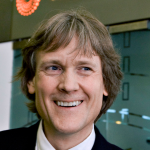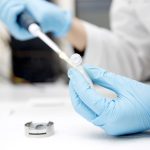Avner Halperin is an entrepreneur, business executive and a physicist. He is also a lecturer on Israeli hi-tech eco-system at the Hebrew University of Jerusalem. He is a father of two boys and two girls, with one of his daughters suffering from asthma. He co-founded EarlySense in 2004 with the initial idea to develop a solution that would empower parents to provide better care to their kids who suffer from asthma at home, preventing hospitalizations and risk of death. The company then began developing a smart contact-free monitoring system that helps parents and doctors identify deteriorating conditions and prevent or minimize attacks before they happen. Thirteen years later, EarlySense's big data sensing and analytics platform is used to monitor hundreds of thousands of patients every year in hospitals and skilled nursing facilities around the world, as well as at home, via a consumer solution. Here Avner tells us more about EarlySense and his aspirations for the future of the company.
Can you tell us more about EarlySense and its services?
EarlySense provides contact-free, continuous monitoring solutions for the medical and consumer digital health markets. EarlySense’s unique sensor utilizes Artificial Intelligence (AI) and big data analytics to provide actionable health insights and improve clinical outcomes.
EarlySense systems are used worldwide in hospitals, rehab and skilled nursing facilities. Our solutions assist clinicians in early detection of patient deterioration, helping to prevent adverse events, including cardiac and respiratory arrests, preventable ICU transfers, patient falls and pressure ulcers. Hospitals and alternate care facilities using EarlySense have repeatedly shown improved clinical and economic outcomes. In many cases, they reported that our systems helped them prevent opioid-related respiratory distress or intervene early on sepsis cases. In skilled nursing facilities, institutions are able to care for more complex patients with the addition of EarlySense solutions, and keep them safe from falls and pressure ulcers.For example, the Allure Group recently reported that it will install EarlySense systems in all its sites.
EarlySense® Live™ is the first at-home consumer health monitor powered by EarlySense’s medically-proven sensor and AI analytics. Live is particularly useful for tracking the health and sleep of the aging population, to support safe and healthy aging at home. Additionally, for parents, it is a valuable tool for tracking children’s health and making timely health choices.
EarlySense has partnered with leading global technology companies including Samsung, Welch Allyn, iFit and Beurer to bring its technology to homes and hospitals.
What challenges would you say you and the company encounter on a regular basis? How are these resolved?
Firstly - bringing a new breakthrough technology to market, especially the healthcare market, often requires changes in workflow and getting customers to initially move out of their comfort zone. It requires upfront investment before reaping the rewards, and although these rewards are eventually very significant, some customers may not get there because of the initial uphill battle.
They key challenge is to build trust and enthusiasm among customers, showing them that the technology is truly valuable and worth the investment. Some key tools we’ve used include:
• Working with key opinion leaders in facilities whose voices are well respected.
• Documenting and communicating success stories. For example, every time a nurse or a physician saves a life using the EarlySense system, we aim to communicate that success within the institution, mentioning the clinician’s name who saved the life.
• Working with third parties to analyze the medical and economic value – this is especially important for early-stage companies – as company-released data is always ‘suspect’ of being biased. Objective, proven third party analysis of value is crucial in building credibility.
• Generating positive PR for our customers, including preparation of marketing kits and support to help customers receive positive attention around the implementation of our solutions. When the customer gains positive PR for implementing our technology, it is a classic win-win situation.
Secondly - recruiting top talent. In any company, especially a hi-tech company, the number one key success factor of the company is not technology or brand, but rather the quality of the people and the ability to keep them engaged. All CEOs have figured that out by now, so how do you attract the best talent?
We constantly strive to provide our people with a sense of mission and accomplishment. EarlySense is working to make the world a better place, and that is a recurring theme that drives our work and energy levels, while significantly limiting attrition. We communicate this mission one step at a time, discussing how we helped save one life, and how many more can and will be saved. For us, it’s more than just a job, it’s a mission that helps us attract the best people time after time.
Embracing diversity is also key. For example in EarlySense, a significant percentage of our engineers are over the age of 60. We also employ extremely talented high school students, so we have range of over 60 years between our youngest and oldest employees (15-76). Additionally, we speak more than 12 native languages in a company of only 135 employees. This makes the team more creative, produces a fun environment and provides access to talented employee pools that others have not yet fully leveraged. By expanding our reach to untapped groups of talent, we continuously bring and keep the best people on board.
How are these challenges set to change, in conjunction with the advent of technologies and the potential future needs of clients?
The key challe that we see in our business is the transition of care from hospital to home, and increased reliance on family caregivers instead of or in addition to professional caregivers as the aging population continuously grows. This means that solutions that were originally developed for hospitals now need to be adapted to homes, and technologies that used to be operated by health professionals now need to be smart and simple enough to be independently operated by elderly patients, their family caregivers and parents to children. Thus advanced predictive analytics and artificial intelligence, which we have been developing for over a decade, becomes crucially important. It is no longer about having the best hardware or the most accurate sensor. It is about the ability to take the information, process it, and direct the end user to make the correct health-related action on his own.
What would you say are EarlySense’s top three priorities towards its clients? How has this evolved over the years?
We want to make our clients more successful in everything they do.
EarlySense is focused on making its clients more successful in their own objectives. In hospitals, we focus on helping them efficiently manage staff and processes towards meeting quality targets – for example shortening length of stay and improving patient satisfaction. In alternate care, the focus is on helping attract more patients, especially those with higher acuity that would in the past be kept in hospitals and are now discharged sooner. We constantly work on providing them solutions that are smart enough to be very simple to use. We aim to empower every patient- facing clinician – even with more limited training – to insure patients are kept safe – i.e. reducing falls and preventing readmissions.
Long term, we work with multiple large scale partners to target the largest market ever for digital health – that of home sensing and care. The leading medical, internet, information technology and consumer electronic companies have all marked the home digital health market as a crucially important growth opportunity and we work with them to make that happen. Such partnerships between relatively small companies and industry giants is always a challenge because we face a significant gap in speed, decision making process and objectives. Building a process that allows small and large companies work closely together as we have done with Hill-Rom/Welch Allyn and Samsung for example, requires patience, flexibility as well as a careful design of the contracts to make sure a win-win situation exists. Direct personal relationship between top leadership as well as equity investment by the giants in the smaller company have proven to be excellent ways to enhance communication, overcome challenges and make sure interests are aligned.
What further goals are you currently working towards with the company and what’s your vision for the future of its services?
We will continue expanding the use of our technology –both medical and consumer solutions- around the world. We will also continue to develop partnerships with the world’s leading IT, medical technology and consumer brands. Additionally, our vision is to build the largest ever cloud database of continuous respiratory, cardiac, and sleep data, and ensure it is leveraged to improve health across the continuum of care – from hospitals, to skilled nursing facilitates and homes.
What is the motivation that drives you?
Founding a company to help address my daughter’s asthma was highly motivating. Over the years, it became clear that there was a much larger need for smart sensors than just that specific use case. Nearly 80% of hospital patients are not closely monitored, which is part of the reason that medical errors are the third leading cause of death in the US. I connected with the larger global issue, with a solution that can help save millions of lives.
I am also driven by the fact that almost every day, EarlySense receives a report about how a patient’s life was saved as a result of doctors responding to our system alerts. Our solution has helped nurses and doctors save, on average, close to 1,000 lives each year, and we’ve only reached 1% of our potential target market. The motivation in expanding our global impact is massive, and energizes us every day.
Website: http://www.earlysense.com










